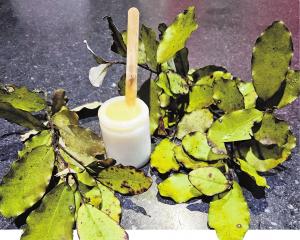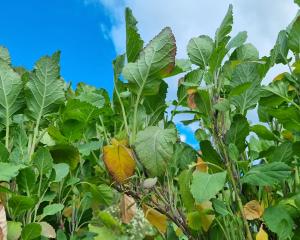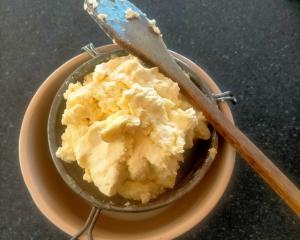

The ground around the trees was covered in the super prickly casings, so we waited until we had some gardening gloves to go back and pick up the nuts. It is a bit like harvesting hedgehogs, or kina.
Don’t mistake the most commonly planted (for some unknown reason) non-edible horse chestnuts. Sweet chestnut leaves are single and serrated, while horse chestnuts leaves are arranged like hands. Sweet chestnuts have super spiky hedgehog-like cases, while horse chestnut cases are almost smooth or with little bumps.
I had read that sweet chestnut flesh makes a great flour alternative, so had to give it a go. The usual method is to make a cut in the skin, then bring the brown nuts to the boil, leave them in the hot water and pick out a few at a time to peel with a knife. If they cool again it will be hard to get the shells off, so re-heat them. The nuts we found were actually easy to peel without the hot water step, but I think this may be an anomaly.
So, with dogged persistence you peel off the brown shell and there is a papery husk inside that needs removing too. I simply could not be bothered with this, so I dried the nuts by the fire until they were really hard and dry and the skins rubbed off easily anyway. I ground them to flour in batches in our little electric coffee and spice grinder. The flour is apparently best frozen for optimum keeping. We used some of ours to make a batch of pasta using ⅓ chestnut flour to ⅔ wheat flour. And the result was really delicious.
Further research on the subject of chestnuts revealed many "chestnuts" of information. The Romans grew chestnuts for food and introduced them to Britain when they invaded. The reason there were few chestnuts in the forests of Scotland is because the tenacious Scots kept the Romans out of their land.
During the German occupation of France in World War 2, the French resistance fighters pretty much lived on chestnuts, which were a readily available source of carbohydrates in the forests.
Most people have heard of pricking the shell of chestnuts (so they don’t explode) and roasting them over a fire, then serving them with lashings of butter and salt. They taste a lot like kumara and have a similar texture.
Chestnuts can be used to make jam by mashing freshly peeled nuts with an equal weight of sugar and cooking with constant stirring until it has a jam consistency. I made a batch and it is indeed a delicious and interesting spread, especially served with ice cream. I tried making marrons glaces, which is the name of a French crystallised chestnut delicacy. I found a recipe and made a batch but was a bit disappointed with the result, so I might leave that one to the French.
I have yet to try chestnut soup, which I expect will be like kumara soup, and mashed cooked chestnuts served as a side dish with a roast of meat.
Chestnuts contain no gluten, very little fat, and are high in vitamin C, so it is a useful flour alternative for some people.
I dug up two little baby chestnut trees from under their roadside parents and have potted these in the hope that one day I will be able to plant them out on a local roadside. It takes at least two trees for pollination to get the fruits to set.
It is not often we come across forage-able carbohydrates, so I have enjoyed making the most of the opportunity to experiment.
I would like to think that if there is hunger in the future, due to climate instability making farming difficult, a crop of roadside chestnuts would be very welcome.
- Each week in this column, one of a panel of writers addresses issues of sustainability.













